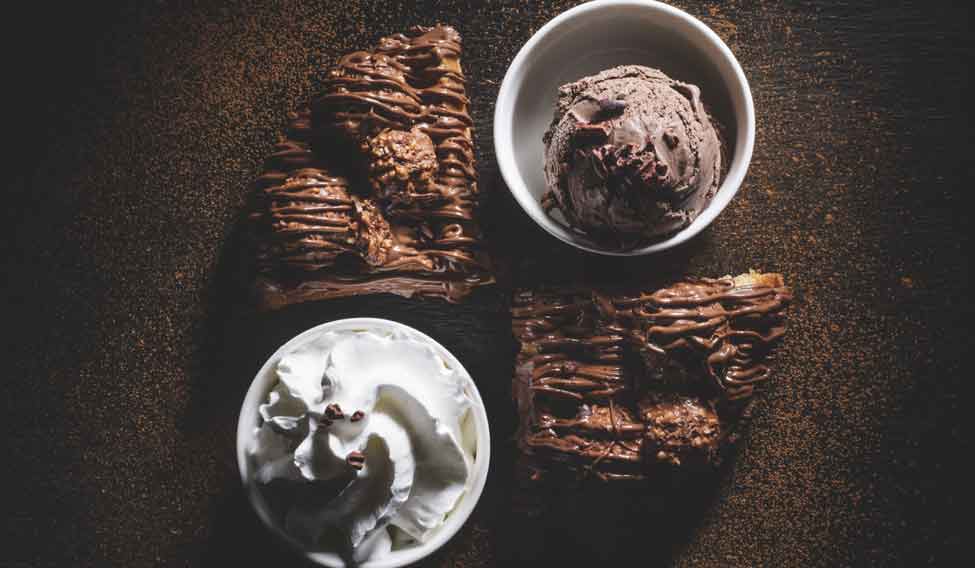The sight of hot, yellow butter melting and fusing in with golden maple syrup atop a soft, fluffy waffle is nothing short of divine. The butter-infused syrup flows around finding its way through the waffle’s honeycombed surface, only to settle down right in time to be devoured wholeheartedly by yet another dessert lover. Many of us, who may not be able to tell where Belgium lies on a world map, would wax eloquent when it comes to the country’s culinary exports to the world—starting from crispy fries to chocolates and waffles. As the USA just wrapped up their National Waffles Day celebrations, let us take a look at the waffle’s origins, how the Americans got it all wrong and a few Indian customisations that are being made on this Belgian dessert-snack:
The history of the waffle
First off, you would be surprised to know that waffles are never eaten for breakfast anywhere in Europe, nor are they served with oodles of maple syrup on it. Waffles are believed to have originated in ancient Greece, then called obelios, with the first ones being ordinary flat cakes roasted between hot metal plates. Typically made using flour and water, this thick wafer began being served by the Catholic Church as a companion to the communion wafer in medieval Europe. The plain, flat bread soon transformed into mini canvasses depicting Biblical scenes and religious icons.
Soon, the dish became a hot favourite in church fairs, with each seller incorporating his/her own additions to the batter and customising the designs to depict landscapes and family crests. With time, the obelios evolved to its present-day grid form, became thicker and airier and were rechristened as wafles (and gaufre in France). Those who sold them became known as waflers and the original circular shape gave way to what is thought to be the more economical, batter-saving rectangular grid.
As the waffle travelled around Europe, every country added their own twist to it to suit their palates. While the Germans added coffee to it, the French enhanced the batter with cloves, wine and lemon zest. Even in Belgium, two kinds of waffles became popular—the Liege waffle, which is thicker and is coated with caramelised sugar, and the Brussels waffle, the thinner, lighter version with smoother edges and deeper pockets. In all these countries, the dish was a street special, eaten by the hand, and served either as a between-meals snack or an after-lunch dessert.
Food historians trace the journey of the wafle to America in the early 17th century, courtesy the Dutch, and along its way, somewhere in 1735, it picked up an extra ‘f’ and came to be known waffles. The Americans welcomed this new dish with open arms and with New York’s Cornelius Swartwout patenting the first stovetop waffle iron in 1869, waffles soon became a much-celebrated breakfast option in many homes.
The Indian connection
Although its origins in India are not accurately mapped out, waffles are thought to be a byproduct of Indian migration to North America, and easier access and growing influence of American television and films on our population. Many restaurants in the country today serve the dish, having made innovations with the batter and having experimented with various toppings, with even some waffle-only chains having sprung up in bigger cities. A wide variety of waffles—ranging from Kitkat waffles to the Broffle (a decadent mix of gooey chocolate brownie and waffles introduced by Mumbai’s Francesco's Pizzeria), fish cake waffles and even Patiala chicken waffles—seems to have captured the Indian foodie’s imagination. Looks like, the waffle is all set to go a long way in India.
 Di Bella Waffle
Di Bella Waffle
Expert tips for the perfect waffle
With a waffle maker in tow, you could enjoy this European favourite right at the comfort of your homes. The ingredients are basic—flour, egg, salt, baking powder, sugar, milk and butter—mixed to form a pourable batter and baked in a hot waffle iron. The secret to the perfect waffle, says Chef Tushar from Kaitlyn’s Beer Garden, lies in the consistency of the batter. A not-too-thick, lump-free, pouring consistency would make sure that your waffles get cooked evenly. Here are a few more such expert tips from top chefs that will make your homemade waffle fluffier, softer and much tastier.
Love it when your waffle is crunchy from the outside, but melt-in-your-mouth soft on the inside? Chef Demetrius of Mumbai’s Francesco’s Pizzeria says that a little patience goes a long way. “The waffle maker should be hot before you put the batter in it,” he says. “Also, sprinkle in a little melted butter over the hot waffle to make it moist and enhance the flavour.”
Want your waffle to be extra special? “Adding your favourite spice such as vanilla, cinnamon or nutmeg in the batter itself gives the waffle a unique flavour,” says Rahul Leekha, owner, Coffee by Di Bella, Mumbai, which serves 25 varieties of freshly baked Belgian waffles.
Chef Anand Morwani of Brewbot, Mumbai (which marks National Waffle Day by adding the Scout and Chocolate Waffle to its menu from today), advises on folding in a freshly whipped egg white to your batter to make lighter waffles.
Don’t go overboard with the egg and sugar, though, warns Rohan D’Souza, head chef of Silver Beach Cafe, as it may brown the batter too quickly and make your waffles soggy too soon.








